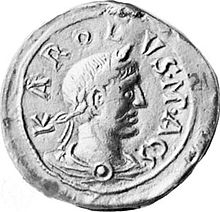
Back Karl III. (Ostfrankenreich) ALS Carl Fætta Francena Cyning ANG تشارلز البدين Arabic تشارلز البدين ARZ Carlos III el Gordu AST Karl der Dicke (gazik ke Germana) AVK شارل فربه AZB Карл III Тоўсты Byelorussian Карл III Тоўсты BE-X-OLD Карл III Bulgarian
This article needs additional citations for verification. (November 2023) |
| Charles the Fat | |
|---|---|
| Emperor of the Romans | |
 A seal of Charles the Fat with the inscription KAROLVS MAGS ("Carolus Magnus") | |
| Emperor of the Carolingian Empire | |
| Reign | 12 February 881 – November 887 |
| Coronation | 12 February 881, Rome |
| Predecessor | Charles II (877) |
| Successor | Guy of Spoleto (891) |
| King of West Francia and Aquitaine | |
| Reign | 12 December 884 – November 887 |
| Coronation | 20 May 885, Grand |
| Predecessor | Carloman II |
| Successor | |
| King of Italy | |
| Reign | 22 March 880 – November 887 |
| Coronation | 12 April 880, Ravenna |
| Predecessor | Carloman |
| Successor | Berengar I |
| King of East Francia and Alemannia | |
| Reign | 28 August 876 – November 887 |
| Predecessor | Louis II |
| Successor | Arnulf |
| Co-rulers | |
| Born | 839 Neudingen (Donaueschingen), Carolingian Empire |
| Died | 13 January 888 (aged 48–49) Neudingen (Donaueschingen), Carolingian Empire |
| Burial | Abbey of Reichenau, Lake Constance (present-day Germany) |
| Spouse | Richardis of Swabia (m. 862) |
| Issue | Bernard (illegitimate) |
| Dynasty | Carolingian |
| Father | Louis II |
| Mother | Emma of Altdorf |
| Religion | Chalcedonian Christianity |
Charles III (839 – 13 January 888), also known as Charles the Fat, was the emperor of the Carolingian Empire[a] from 881 to 887. A member of the Carolingian dynasty, Charles was the youngest son of Louis the German and Hemma, and a great-grandson of Charlemagne. He was the last Carolingian emperor of legitimate birth and the last to rule a united kingdom of the Franks.
Over his lifetime, Charles became ruler of the various kingdoms of Charlemagne's former empire. Granted lordship over Alamannia in 876, following the division of East Francia, he succeeded to the Italian throne upon the abdication of his older brother Carloman of Bavaria who had been incapacitated by a stroke. Crowned emperor in 881 by Pope John VIII, his succession to the territories of his brother Louis the Younger (Saxony and Bavaria) the following year reunited the kingdom of East Francia. Upon the death of his cousin Carloman II in 884, he inherited all of West Francia, thus reuniting the entire Carolingian Empire.
Usually considered lethargic and inept—he was frequently ill, and is believed to have had epilepsy—Charles twice purchased peace with Viking raiders, including at the infamous Siege of Paris, which led to his downfall.
The reunited empire did not last. During a coup led by his nephew Arnulf of Carinthia in mid-November 887, Charles was deposed in East Francia, Lotharingia, and the Kingdom of Italy. Forced into quiet retirement, he died of natural causes on 13 January 888, just a few weeks after his deposition.[2] The Empire quickly fell apart after his death, splintering into five separate successor kingdoms; the territory it had occupied was not entirely reunited under one ruler until the conquests of Napoleon.
- ^ Brunel, Ghislain (2007). "Les cisterciens et Charles V". Société de l'histoire de France: 79. JSTOR 23408518.
- ^ "Karl III". Neue Deutsche Biographie.
Cite error: There are <ref group=lower-alpha> tags or {{efn}} templates on this page, but the references will not show without a {{reflist|group=lower-alpha}} template or {{notelist}} template (see the help page).
© MMXXIII Rich X Search. We shall prevail. All rights reserved. Rich X Search